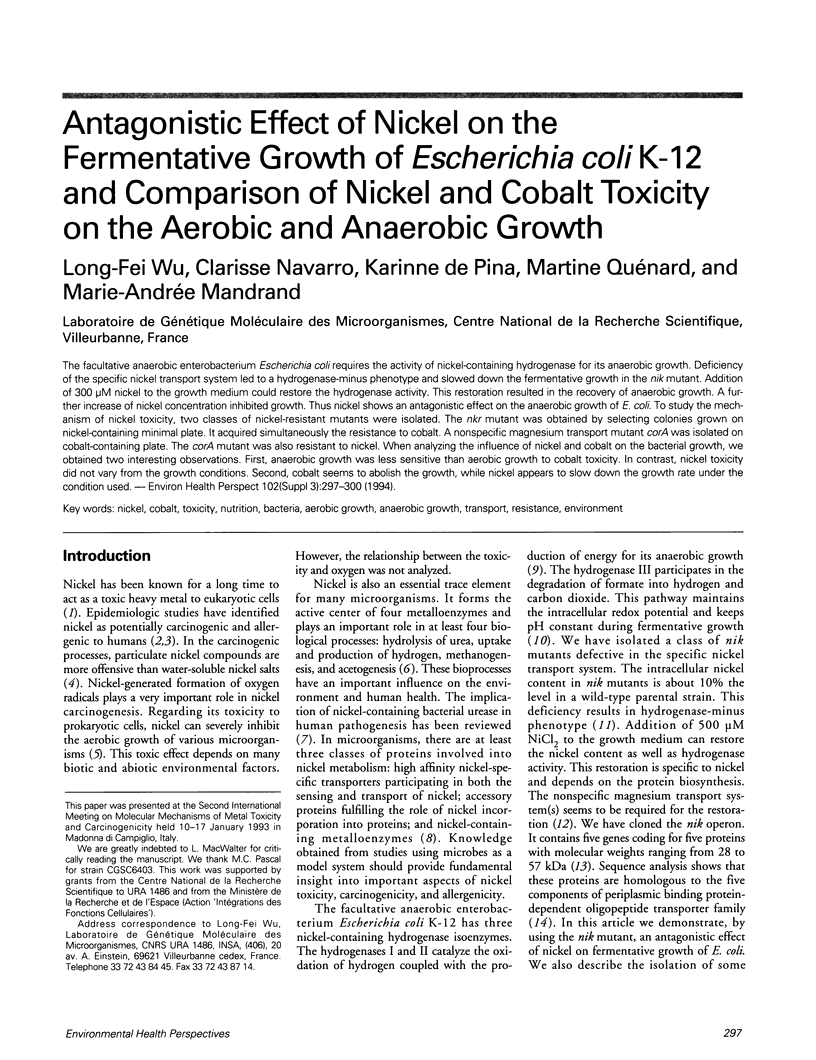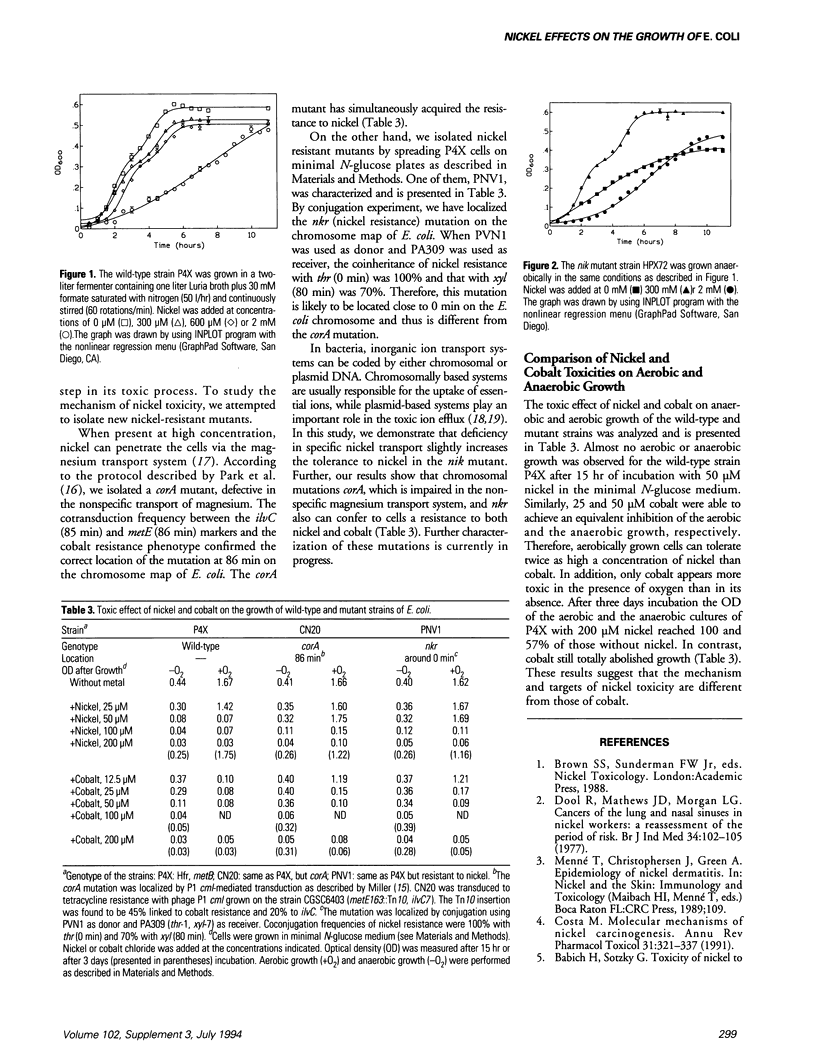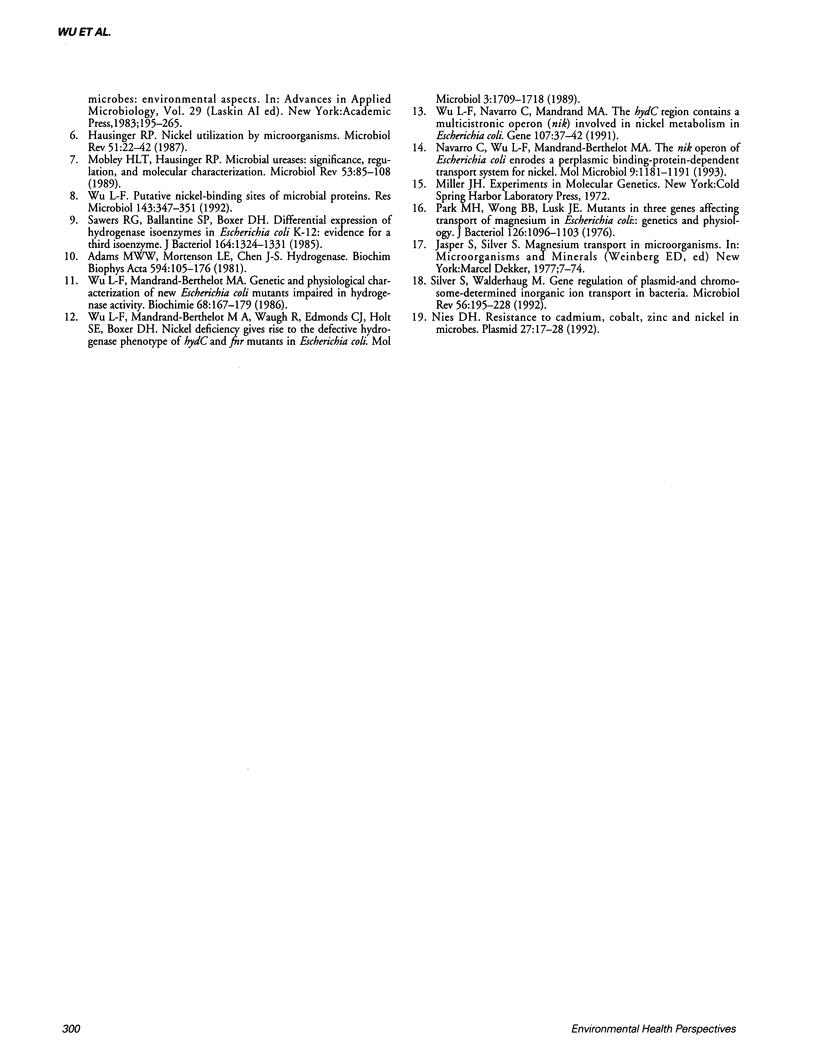Abstract
The facultative anaerobic enterobacterium Escherichia coli requires the activity of nickel-containing hydrogenase for its anaerobic growth. Deficiency of the specific nickel transport system led to a hydrogenase-minus phenotype and slowed down the fermentative growth in the nik mutant. Addition of 300 microM nickel to the growth medium could restore the hydrogenase activity. This restoration resulted in the recovery of anaerobic growth. A further increase of nickel concentration inhibited growth. Thus nickel shows an antagonistic effect on the anaerobic growth of E. coli. To study the mechanism of nickel toxicity, two classes of nickel-resistant mutants were isolated. The nkr mutant was obtained by selecting colonies grown on nickel-containing minimal plate. It acquired simultaneously the resistance to cobalt. A nonspecific magnesium transport mutant corA was isolated on cobalt-containing plate. The corA mutant was also resistant to nickel. When analyzing the influence of nickel and cobalt on the bacterial growth, we obtained two interesting observations. First, anaerobic growth was less sensitive than aerobic growth to cobalt toxicity. In contrast, nickel toxicity did not vary from the growth conditions. Second, cobalt seems to abolish the growth, while nickel appears to slow down the growth rate under the condition used.
Full text
PDF



Selected References
These references are in PubMed. This may not be the complete list of references from this article.
- Adams M. W., Mortenson L. E., Chen J. S. Hydrogenase. Biochim Biophys Acta. 1980 Dec;594(2-3):105–176. doi: 10.1016/0304-4173(80)90007-5. [DOI] [PubMed] [Google Scholar]
- Costa M. Molecular mechanisms of nickel carcinogenesis. Annu Rev Pharmacol Toxicol. 1991;31:321–337. doi: 10.1146/annurev.pa.31.040191.001541. [DOI] [PubMed] [Google Scholar]
- Doll R., Mathews J. D., Morgan L. G. Cancers of the lung and nasal sinuses in nickel workers: a reassessment of the period of risk. Br J Ind Med. 1977 May;34(2):102–105. doi: 10.1136/oem.34.2.102. [DOI] [PMC free article] [PubMed] [Google Scholar]
- Hausinger R. P. Nickel utilization by microorganisms. Microbiol Rev. 1987 Mar;51(1):22–42. doi: 10.1128/mr.51.1.22-42.1987. [DOI] [PMC free article] [PubMed] [Google Scholar]
- Mobley H. L., Hausinger R. P. Microbial ureases: significance, regulation, and molecular characterization. Microbiol Rev. 1989 Mar;53(1):85–108. doi: 10.1128/mr.53.1.85-108.1989. [DOI] [PMC free article] [PubMed] [Google Scholar]
- Navarro C., Wu L. F., Mandrand-Berthelot M. A. The nik operon of Escherichia coli encodes a periplasmic binding-protein-dependent transport system for nickel. Mol Microbiol. 1993 Sep;9(6):1181–1191. doi: 10.1111/j.1365-2958.1993.tb01247.x. [DOI] [PubMed] [Google Scholar]
- Nies D. H. Resistance to cadmium, cobalt, zinc, and nickel in microbes. Plasmid. 1992 Jan;27(1):17–28. doi: 10.1016/0147-619x(92)90003-s. [DOI] [PubMed] [Google Scholar]
- Park M. H., Wong B. B., Lusk J. E. Mutants in three genes affecting transport of magnesium in Escherichia coli: genetics and physiology. J Bacteriol. 1976 Jun;126(3):1096–1103. doi: 10.1128/jb.126.3.1096-1103.1976. [DOI] [PMC free article] [PubMed] [Google Scholar]
- Sawers R. G., Ballantine S. P., Boxer D. H. Differential expression of hydrogenase isoenzymes in Escherichia coli K-12: evidence for a third isoenzyme. J Bacteriol. 1985 Dec;164(3):1324–1331. doi: 10.1128/jb.164.3.1324-1331.1985. [DOI] [PMC free article] [PubMed] [Google Scholar]
- Silver S., Walderhaug M. Gene regulation of plasmid- and chromosome-determined inorganic ion transport in bacteria. Microbiol Rev. 1992 Mar;56(1):195–228. doi: 10.1128/mr.56.1.195-228.1992. [DOI] [PMC free article] [PubMed] [Google Scholar]
- Wu L. F., Mandrand-Berthelot M. A. Genetic and physiological characterization of new Escherichia coli mutants impaired in hydrogenase activity. Biochimie. 1986 Jan;68(1):167–179. doi: 10.1016/s0300-9084(86)81081-1. [DOI] [PubMed] [Google Scholar]
- Wu L. F., Mandrand-Berthelot M. A., Waugh R., Edmonds C. J., Holt S. E., Boxer D. H. Nickel deficiency gives rise to the defective hydrogenase phenotype of hydC and fnr mutants in Escherichia coli. Mol Microbiol. 1989 Dec;3(12):1709–1718. doi: 10.1111/j.1365-2958.1989.tb00156.x. [DOI] [PubMed] [Google Scholar]
- Wu L. F., Navarro C., Mandrand-Berthelot M. A. The hydC region contains a multi-cistronic operon (nik) involved in nickel transport in Escherichia coli. Gene. 1991 Oct 30;107(1):37–42. doi: 10.1016/0378-1119(91)90294-l. [DOI] [PubMed] [Google Scholar]
- Wu L. F. Putative nickel-binding sites of microbial proteins. Res Microbiol. 1992 Mar-Apr;143(3):347–351. doi: 10.1016/0923-2508(92)90027-l. [DOI] [PubMed] [Google Scholar]


